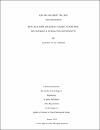Refugee Camps: Initiation, Current Conditions, Development & Integration with the City
| Advisor | Solder, Anna Grichting |
| Author | Awwad, Rana M. W. M. |
| Available date | 2018-12-19T11:20:37Z |
| Publication Date | 2018-01 |
| Abstract | The issue of Palestinian refugees exists for nearly 70 years now, starting from the occupation of Palestine by Israeli forces and immigrants in the late 40s. Approximately 900,000 Palestinian refugees were forced to leave Palestine following the 1948 Arab– Israeli war. The majority of them fled to neighboring Arab countries; Jordan, Lebanon, Syria and Egypt. Following the 1967 war; another wave of Palestinian refugees fled to Jordan, when Israel occupied the Gaza and West Bank along with other Arab territories. These waves of refugees who moved to Jordan transformed its demographic structure and reformed Jordan’s socio-economic, political, and cultural life. The Syrian conflict and civil war onwards of 2011 has seen thousands of Syrian and Palestinian refugees being forced to leave Syria and move to adjacent countries, creating accommodation issues for the hosts. The governments of the said host nations found it essential to formulate new policies to accommodate the refugee flux. One of the major historical issues of refugee camps is that they are considered by both the host governments and refugees themselves as a temporary solution until the conflict gets resolved. In some cases, however, what began as temporary arrangements have morphed into permanent residences; this is, especially true of the hapless Palestinian refugees. This research studies the structure and development of the refugee camps and looks at ways in which the camps can be better integrated with the surrounding cities and communities. It also provides a high-level study for two cases in Jordan, Al-Baqaa and Al-Zaatari refugee camps, with a particular focus on their edges and connections with the surrounding urban and social fabric. The areas of concern were explored in several ways starting from the literature review for the background and history, analyzing case studies, interviewing refugees and involved personnel ending with summarizing the outcomes. The research concludes by proposing urban design enhancements that can be implemented in the existing camps to create a better interface with the adjoining land and settlements. These are accompanied by a list of recommendations to modify the legislation and to create best practices for future refugee camps. |
| Language | en |
| Subject | Refugee Camps Integration Urban Fabric Social Life |
| Type | Master Thesis |
| Department | Urban Planning and Design |
Files in this item
This item appears in the following Collection(s)
-
Urban Planning and Design [44 items ]


